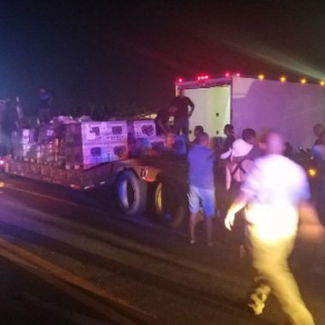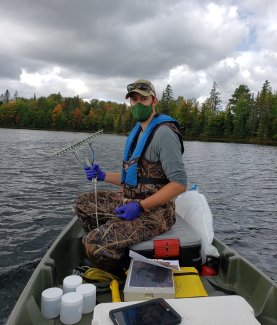A Resilient Observatory: Dealing with Disasters
November 1, 2023
From hurricanes to wildfires to health crises, a lot can happen in the life of a 30-year ecological program—and a lot already has. The National Ecological Observatory Network (NEON) has weathered several unexpected events. Some, such as natural disasters, only impact a single field site or a few regional sites. Others, like the COVID-19 pandemic, have had more wide-ranging consequences. Through it all, the Observatory team, managed by Battelle, has responded with ingenuity, resilience, and a positive spirit to ensure the safety of our people and maximize data continuity and availability.
Forces of Nature
NEON field sites are vulnerable to a broad range of extreme weather events and other potential natural disasters. In California, wildfires and earthquakes are primary concerns. In Puerto Rico and along the Gulf and Atlantic Coasts, hurricanes are the biggest threat. Other parts of the continent may face dust storms, tornados, severe thunderstorms, flooding, blizzards, tsunamis, landslides, or even (in Hawaii) volcanic activity. Safety and contingency plans for the NEON program must be robust and flexible enough to handle virtually anything. Above all, the safety of Observatory staff comes first.
Kirsten Ruiz, the Director of Field Science, has been with the NEON program since 2008 and has seen her share of disruptive events. "When we talk about natural disasters, our people are always our first priority," she says. "Ensuring the safety of our field teams is more important than having a complete data set."
That philosophy was demonstrated in the fall of 2017 when Hurricane Maria struck Puerto Rico—one of the first major natural disasters the NEON program dealt with. When the Category 4 hurricane hit the island, the four Atlantic Neotropical (D04) field sites had just transitioned from construction to full operations. The first step was establishing communications with NEON staff and making sure they were safe and had everything they needed. Battelle sent several pallets of emergency supplies to support field personnel and their families, including generators, food, bottled water, and other materials.

Hurricane Maria relief in Domain 04, Puerto Rico.
Data continuity and quality are the next considerations in any emergency. At the D04 field sites, the towers were built to withstand hurricane-force winds, and staff took measures before the storm hit to protect delicate equipment. After the hurricane, field personnel quickly established safe travel routes to the field office and tower sites to get things up and running. Thanks to resilient infrastructure design, advance preparation, and the team's dedication in the immediate aftermath of the hurricane, field data collection for most data sets resumed within weeks.
Lessons learned during Maria have informed the response to other natural disasters. In 2019 and 2020, Puerto Rico was hit by a series of earthquakes, with extensive damage to homes and infrastructure in parts of the island, including the NEON field offices. Rather than a single event, the earthquakes caused disruption over several weeks, requiring field teams to adapt to changing conditions on an ongoing basis. When an earthquake hit the Great Basin (D15) field office in Utah in March of 2020, experience gained in Puerto Rico was quickly put into action.
"We had a model for how to reopen, based on the scale of the crisis at hand," says Ruiz. "When is it safe for field staff to enter the office? Who should go first? Who cleans up broken glass and electronics and makes sure the area is safe for others to enter? How do we communicate with field staff?" Protocols developed for responding to emergencies include daily check-ins to determine needs on the ground, detailed checklists to ensure action items are addressed, and proactive communication to reduce uncertainty and facilitate rapid recovery. The response team may involve not only NEON staff, but also the Battelle security, HR, and communication teams.
The NEON program also provides robust training and an extensive written Field Safety and Security Plan. Training is focused on the types of emergencies most likely to impact different field sites and offices, and the safety plans are always evolving as staff learn from experiences in the field.
The COVID-19 Pandemic
The COVID-19 pandemic presented new challenges for the NEON teams. While natural disasters typically impact one or a handful of sites, the pandemic required a response across the entire Observatory. Ruiz says, "When COVID-19 first started emerging on the West Coast in January of 2020, there was a lot of uncertainty about how big it would be and how much impact it would have. We had to stay in close touch with the teams and with local governments in those areas to make sure we were following all local safety protocols."
By mid-March 2020, COVID-19 had shut down in-person field activities and NEON offices across the country—along with most of public life across the globe. Nearly every aspect of operations needed to be reevaluated and, in some cases, put on hold.
"At first, we didn't know how long it would last. We thought we would be back to normal operations within a few weeks," Ruiz explains. Not wanting to lose an entire year of field data collection, the education team quickly launched a virtual training program to get seasonal field staff onboarded. The NEON program developed new policies for remote work and protocols for the returning field teams. During the 2020 season, field teams were kept small and static to minimize exposures. "Our workforce often works, travels, and lives together, so we had to look at things more holistically," says Ruiz. "It's not just about what they are doing at work, but who they are in contact with at home. We had to evaluate how we would handle driving in vehicles, overnight lodging, and team structure to minimize risks and keep people safe."
From a data continuity perspective, the pandemic did result in some gaps in observational data during the 2020 season. However, instrument data continued to be collected at most field sites with little or no disruption. Remote monitoring allowed the instrument teams to oversee and troubleshoot equipment from the field office (or home) and decide when a situation required an on-site technician.

Domain 05 field ecologist prepares to collect aquatic plants at the CRAM lake field site using a rake. Photo credit: Hannah Beeler.
Communicating with NEON data users was crucial during the pandemic. Some assignable assets projects had to be delayed or redesigned, and researchers needed to be aware of any data gaps that impacted their work. Bonnie Meinke, Engagement Team Lead until September 2023, commented, "The pandemic was the great equalizer. Often, the user community just thinks of the NEON program in terms of operations, equipment, and data. But with the pandemic came the realization that these are real people doing things in the field." Many NEON scientists and technicians refocused their work during the pandemic on helping the user community shift to instrument data. "NEON ramped up the education programs, including data skills training, for the user community to help them use the data and to continue with research while they were stuck inside," said Meinke.
After more than three years of pandemic response, the Observatory stopped checking for community spread in May 2023. Ruiz says, "The response by our people to the pandemic has been amazing from day one. When field operations were paused in March 2020, everyone worked together to brainstorm ways we could continue to add value for the user community. Regardless of your job on March 14, on March 16, you had a new temporary role." Thanks to the dedication and creativity of the NEON field teams, disruptions to data continuity were kept to a minimum, and the NEON program found new ways to serve the user community.
A Culture of Safety and a Commitment to Data Integrity
The NEON Field Safety and Security Plan continues to evolve as NEON learns from each new challenge. Meinke said, "It's about experience. With a distributed Observatory of this size, there is the potential to be exposed to all kinds of events. By this point, there is a good sampling of the kinds of disruptions that can be expected across field sites, and NEON can apply the lessons learned to develop more robust and effective response plans."
As response strategies evolve, the focus will continue to be first on personnel safety and second on data integrity and continuity. Ruiz says, "It's more than just checking boxes. We need people to be safe, but we also need them to feel safe when they go back to work. That means addressing their concerns, being transparent, and doing what we can to reduce uncertainty for people. We have a real culture of safety on the ground across the NEON field sites every day. We don't expect people to trust us; instead, we act in ways that are trustworthy, so they know that what we say is credible. Maintaining that trust, for our people and user community, is our first priority."
